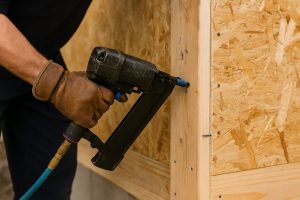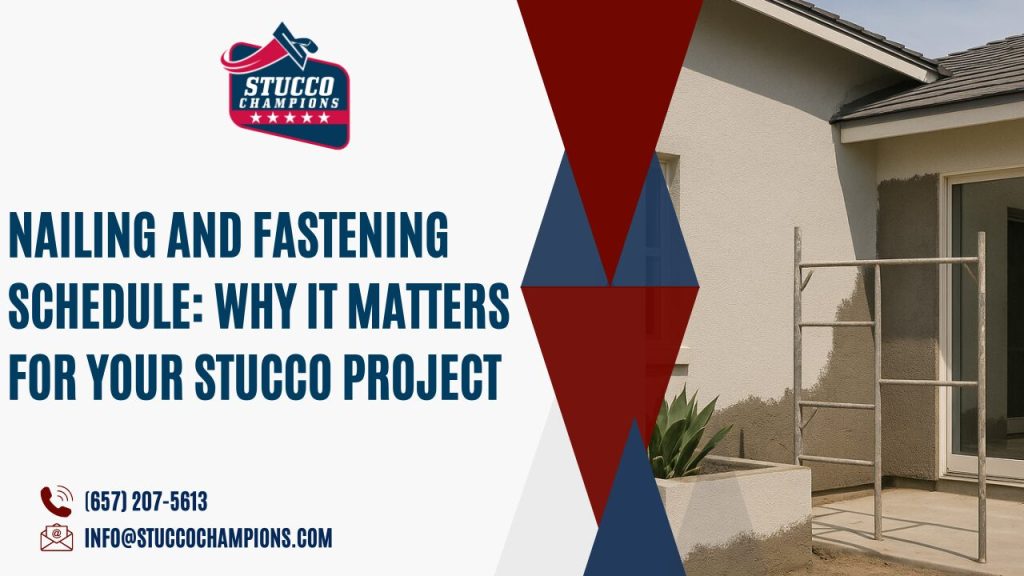Nailing and Fastening Schedule: Why It Matters for Your Stucco Project

When it comes to stucco work, most homeowners focus on the finish—smooth or sanded, painted or natural—but the truth is, the quality of the finish depends entirely on what’s underneath. One of the most overlooked but critical steps in stucco application is the nailing and fastening schedule for the wall and roof sheathing. This step determines whether your stucco will last for decades or start cracking and failing within a few seasons.
At Stucco Champions, we don’t cut corners. Our crews follow strict fastening guidelines based on IRC (International Residential Code) and APA (Engineered Wood Association) standards to make sure every project is built to last.
Why Fastening Matters
Stucco is a rigid exterior system. If the surface beneath it moves, shifts, or pulls away from the framing, the stucco will crack. Proper fastening of the sheathing—whether it’s plywood or OSB (Oriented Strand Board)—ensures a stable base that can handle weight, moisture, temperature changes, and even seismic activity.
Incorrect or inconsistent fastening can lead to:
-
Warped or uneven walls
-
Hairline or spiderweb cracking
-
Moisture intrusion behind the stucco
-
Premature failure of the entire system
That’s why we always begin with a code-compliant and precision-executed fastening schedule.
Wall Sheathing Fastening (Per IRC Standards)
Below is a table outlining the correct fastening pattern for vertical wall panels:
| Element | Specification |
|---|---|
| Edge Spacing | Fasten every 6 inches along all panel edges |
| Field Spacing | Fasten every 12 inches throughout the field |
| Fastener Type | 8d common nails (2½”) or code-approved screws |
These standards aren’t optional—they’re mandated by code and backed by structural testing. If your home is in an area with high wind loads or seismic activity, following these specs becomes even more important.
Roof Sheathing Fastening
Roof sheathing also supports stucco eaves, fascia, and sometimes architectural features like parapets or soffits. Improper fastening here can lead to sagging or separation over time.
| Element | Specification |
|---|---|
| Edge Spacing | Fasten every 6 inches |
| Field Spacing | Fasten every 12 inches |
| Fastener Type | 8d nails or screws (if specified by plans) |
When needed, we also use hurricane clips or truss clips to strengthen the roof-to-wall connection, giving your structure added resilience.
Nail Depth and Fastening Precision
Using the right fasteners isn’t enough. Depth control is critical. Both overdriven and underdriven nails can cause failures in the sheathing layer.
| Problem | Cause | Consequence |
|---|---|---|
| Overdriven Nails | Nail sinks too deep into panel | Weakens holding power, causes movement |
| Underdriven Nails | Nail head sticks out from surface | Prevents flush stucco bonding |
| Angled or Skipped Nails | Poor tool control or fatigue | Leads to uneven surface, poor adhesion |
We use depth-controlled nail guns to ensure every fastener is driven correctly. We also inspect all sheathing before applying paper and lath to catch any weak points.
Why It Matters for Stucco Longevity
Stucco is only as strong as the surface it’s bonded to. If your sheathing is poorly installed—loose, bowed, or underfastened—it will eventually shift and cause cracking, bubbling, or detachment of the finish coat. That’s why a proper fastening schedule is foundational to a successful stucco job.
By adhering to ASTM standards and the IRC code, Stucco Champions ensures that every home we touch has the structural integrity to hold up over time, whether you choose a sand finish or a sleek smooth coat.
Built for California Weather
In Southern California, where temperatures swing and humidity varies by season, a proper fastening system gives your stucco the flexibility and strength to expand and contract without issue. Combined with correct lath, waterproofing, and finish coats, fastening sets the tone for decades of performance.
Final Thoughts
If you’re investing in new stucco or planning a full re-stucco, don’t overlook the basics. While it may seem like a hidden part of the process, nailing and fastening is where long-term quality begins.
Whether you’re building from scratch or replacing an aging exterior, trust the pros who treat every step like it matters—because it does.
Ready to Simplify Your Stucco Work?
Contact Stucco Champions today for a free consultation!
Visit us at Stucco Champions for helpful resources and to learn more about our services.

